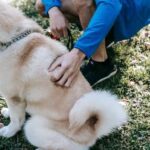Can you train your dog to be a guard dog? Guard dogs play a crucial role in protecting homes and properties, providing security and peace of mind to their owners. These specially trained canines are equipped with the skills to detect and deter potential threats, making them valuable assets for safeguarding against intruders. Understanding the traits of certain breeds that make them suitable for guard dog training is essential in identifying the right candidate for this important role.
When considering training a dog to be a guard dog, it is important to recognize that not all breeds possess the innate qualities necessary for this task. Breeds like German Shepherds, Doberman Pinschers, Rottweilers, and Belgian Malinois are known for their protective instincts, intelligence, and loyalty – making them ideal candidates for guard dog training. These traits set the foundation for successful training techniques and strategies aimed at developing a reliable guard dog capable of responding effectively to commands and threats.
Training methods for guard dogs encompass various aspects such as socialization, obedience training, protection training, and building trust between the owner and the canine companion. Through proper socialization, guard dogs learn to differentiate between real threats and everyday situations, enabling them to respond appropriately when faced with danger.
Obedience training establishes clear communication channels between the owner and the dog, fostering a strong bond based on trust and respect. By focusing on these key elements, owners can effectively train their furry friends to become dependable guardians of their homes and loved ones.
Understanding the Breed
When it comes to training a dog to be a guard dog, understanding the breed is crucial. Not all dog breeds are suitable for guard dog training due to their inherent characteristics and temperaments. Some breeds are naturally more protective, while others may lack the instinct or physical attributes required for such a role. Here are some key traits to look for in breeds that can be trained as effective guard dogs:
- Size and Strength: Large and muscular breeds such as German Shepherds, Rottweilers, and Doberman Pinschers are commonly used as guard dogs due to their imposing presence and physical capabilities.
- Intelligence: Breeds known for their intelligence, such as Belgian Malinois and Dobermans, are highly trainable and quick learners, making them ideal candidates for guard dog training.
- Loyalty: Dogs that exhibit strong loyalty to their owners, like the Akita or Bullmastiff, are more likely to protect their family and territory without hesitation.
It’s important to remember that breed alone does not determine a dog’s suitability as a guard dog. Each individual dog has its own personality and experiences that can influence its behavior. Proper training and socialization play a significant role in developing a reliable guard dog regardless of its breed. With the right approach, almost any breed can you train your dog to be a guard dog.
- Determining Factors: Consider factors such as energy level, prey drive, territorial instincts, and socialization when selecting a breed for guard dog training.
- Temperament Testing: Conduct temperament tests or seek guidance from professional trainers to assess whether a particular breed is suitable for guarding duties.
Training Methods
Training a dog to be a guard dog requires specific techniques and strategies to ensure its effectiveness in protecting your home and property. One of the most common methods used is positive reinforcement training, where desired behaviors are rewarded with treats or praise. This encourages the dog to repeat those behaviors in the future. Consistency is key in this approach, as the dog needs to understand what actions lead to rewards.
Another technique often used in guard dog training is desensitization and counter-conditioning. This involves exposing the dog to various stimuli that may trigger protective responses, such as strangers approaching the property. By gradually introducing these stimuli in a controlled manner and pairing them with positive experiences, the dog can learn not to react aggressively unless a real threat is present. This method helps the dog distinguish between normal situations and actual dangers.
Additionally, utilizing experienced trainers or enrolling your dog in specialized guard dog training programs can you train your dog to be a guard dog can provide structured guidance and professional expertise. These programs often incorporate obedience, protection, and agility training tailored specifically for guard dogs. Working with professionals can help ensure that your dog receives comprehensive and effective training to fulfill its role as a reliable guardian.
| Guard Dog Training Techniques | Description |
|---|---|
| Positive Reinforcement Training | Rewarding desired behaviors with treats or praise to encourage repetition. |
| Desensitization and Counter-Conditioning | Exposing the dog to stimuli gradually while pairing them with positive experiences to prevent aggressive reactions. |
| Professional Guard Dog Training Programs | Enrolling in specialized programs led by experienced trainers for comprehensive training tailored for guard dogs. |
Socialization
Socializing guard dogs plays a crucial role in their ability to effectively distinguish between threats and non-threats. When it comes to training your dog to be a guard dog, socialization is a key component that should not be overlooked. Exposing your dog to various people, animals, environments, and situations from a young age can help them develop the necessary discernment skills needed for guarding duties.
Early Socialization
Early socialization is essential in shaping a guard dog’s behavior and temperament. Introducing your dog to different stimuli in a positive and controlled manner
Exposing Your Dog to Various Environments
Exposing your guard dog to various environments such as parks, busy streets, markets, and even loud noises
Training With Different People
Allowing your guard dog to interact with different individuals – including family members, friends, strangers (under supervision), and even professionals like veterinarians or trainers –
Obedience Training
Benefits of Obedience Training
Obedience training plays a crucial role in developing a guard dog’s response to commands. Through obedience training, owners
By teaching basic commands such as sit, stay, come, and heel, owners can establish clear communication with their guard dogs, ensuring they understand and obey instructions promptly. Consistent obedience training also helps in strengthening the bond between the owner and the dog, fostering trust and loyalty.
Training Techniques for Obedience
When it comes to obedience training for guard dogs, positive reinforcement techniques prove to be highly effective. Rewarding good behavior with treats, praise, or playtime encourages the desired responses from the dog while promoting a positive learning environment.
Additionally, using a firm but gentle approach during training sessions helps convey authority without instilling fear in the dog. Consistency is key in obedience training, with regular practice sessions scheduled throughout the week to reinforce commands and ensure compliance from the guard dog.
Advanced Obedience Skills for Guard Dogs
In addition to basic commands, guard dogs undergoing obedience training should also be taught advanced skills that are essential for their protective role. Advanced obedience skills may include tasks like alerting to strangers or intruders, performing perimeter checks of the property when commanded to do so, and responding immediately to emergency recall signals.
These advanced skills not only enhance the guard dog’s ability to protect its owners and territory but also provide peace of mind knowing that they are well-prepared for any security threats that may arise.
Protection Training
When it comes to training your dog to be a guard dog, protection training plays a crucial role in developing the specific skills and behaviors necessary for them to effectively protect their owners and territory. This type of training focuses on honing the natural instincts of the dog and teaching them how to respond appropriately to potential threats. Here are some key skills and behaviors that are typically included in protection training:
- Alertness: Guard dogs need to be alert at all times, able to detect any sign of danger or intrusion. Training them to be attentive and vigilant can enhance their ability to protect their surroundings.
- Barking: Teaching your dog when and how to bark as a warning signal is essential in protection training. A well-trained guard dog should know when barking is needed to alert their owners or deter intruders.
- Controlled aggression: While guard dogs need to exhibit a certain level of aggressiveness towards potential threats, it is crucial that this aggression is under control. Training your dog to differentiate between real threats and non-threats can prevent any unnecessary aggressive behavior.
Additionally, physical conditioning through exercises like agility training can improve the overall fitness and strength of your guard dog, enabling them to respond quickly and effectively in challenging situations. It is important to remember that protection training should always be conducted under the guidance of professional trainers who understand the specific needs of guard dogs. With proper training and consistent practice, your dog can develop into a reliable protector for you and your property.
- Conducted by professional trainers
- Physical conditioning through exercises like agility training
Building Trust
Guard dogs are a valuable asset when it comes to home security, as they provide not only protection but also companionship. One common question that arises is whether you can train your dog to be a guard dog.
The answer is yes, with the right training and techniques, almost any breed can be trained to fulfill the role of a guard dog. However, it’s essential to understand that certain breeds naturally possess traits that make them more suitable for guard dog training.
When it comes to building trust between the owner and the guard dog, consistency and positive reinforcement are key. Dogs thrive on routine and clear communication, so establishing a consistent training schedule helps create a sense of stability and reliability for the dog. Positive reinforcement techniques such as treats, praise, and playtime can help strengthen the bond between owner and dog. It’s important for owners to be patient and understanding during the training process as building trust takes time.
Another crucial aspect of building trust with a guard dog is ensuring mutual respect between the owner and the pet. Dogs respond well to authoritative yet compassionate leadership. By setting clear boundaries through obedience training and consistently enforcing rules, owners can establish themselves as leaders in their canine companion’s eyes. This not only enhances the protective instinct of the guard dog but also fosters a harmonious relationship based on trust and respect.
| Aspect | Details |
|---|---|
| Training Techniques | Consistency & positive reinforcement |
| Mutual Respect | Authoritative yet compassionate leadership |
Legal Considerations
When considering training your dog to be a guard dog, it is crucial to understand the legal aspects and responsibilities that come with owning such a trained animal. In many jurisdictions, owning a guard dog implies certain liabilities for the owner.
If a guard dog were to injure someone or trespass on another person’s property, the owner could be held legally responsible. Therefore, it is essential to be aware of the laws regarding guard dogs in your area and take necessary precautions to prevent any unfortunate incidents.
One important legal consideration when owning a guard dog is ensuring that you have the proper training certifications for your canine companion. Some regions require specific certifications or licenses for those who train guard dogs.
These certifications often involve proving that your dog has undergone adequate training in obedience, protection skills, and socialization. Additionally, having these certifications can demonstrate to others that your guard dog has been trained responsibly and may help mitigate any potential legal issues in case of an incident.
Furthermore, it is essential to consider the ethical implications of training your dog to be a guard dog. While having a well-trained guard dog can provide security for your home and family, it is imperative to ensure that the methods used in training are humane and do not compromise the well-being of the animal.
Guard dogs should receive love, care, and positive reinforcement throughout their training to develop a healthy bond with their owners while still being effective protectors. Adhering to ethical standards in training not only ensures the welfare of the dog but also contributes to creating a reliable and stable working relationship between them and their owners.
Real-Life Stories
Training a dog to be a guard dog is not an easy task, but with dedication and the right approach, it is indeed possible. Many owners have shared their success stories of transforming their beloved pets into reliable protectors of their homes and families.
One such story is that of Sarah, who decided to train her German Shepherd, Max, as a guard dog after a break-in incident in her neighborhood. With consistent training and positive reinforcement, Max developed keen instincts and a strong sense of loyalty towards Sarah and her family.
Another inspiring tale comes from John, who trained his Rottweiler, Bella, to be a guard dog for his remote property. Through obedience training and protection exercises, Bella learned to patrol the perimeter effectively and alert John to any potential threats. John’s commitment to Bella’s training paid off when her quick thinking and barking alerted him to an intruder one night, ultimately deterring any harm.
These real-life stories serve as a testament to the fact that with patience, persistence, and proper training techniques, you can indeed train your dog to be a reliable guard dog. Building a strong bond with your pet, understanding its breed traits, and engaging in consistent socialization are key factors in shaping a well-rounded protector.
By investing time and effort into your canine companion’s development as a guard dog, you can enhance both your safety and the security of your property.
Conclusion
In conclusion, the question “Can You Train Your Dog to Be a Guard Dog?” is met with a resounding yes.
As discussed throughout this article, the process of training a dog to be a guard dog involves understanding the breed, employing effective training methods, emphasizing socialization and obedience training, focusing on protection skills, building trust between owner and dog, and considering legal responsibilities. By following these key components and dedicating time and effort to proper training, any dog has the potential to become a reliable guard dog.
Choosing the right breed is essential in determining the success of guard dog training. Breeds like German Shepherds, Doberman Pinschers, Rottweilers are known for their protective instincts and intelligence which make them suitable candidates for guard dog work. Additionally, it is important to recognize that each individual dog has its own personality and strengths that can be harnessed through consistent training and reinforcement.
Ultimately, owning a guard dog requires commitment from the owner in terms of time, resources, and responsibility. While the idea of having a well-trained guard dog to protect your home may sound appealing, it is crucial to remember that proper training should prioritize safety for both the dog and those around them. With dedication and patience, owners
Frequently Asked Questions
Can I Make My Dog a Guard Dog?
Making your dog a guard dog is possible with the right training and temperament. It is important to work with a professional trainer to ensure the safety and well-being of both your dog and those around you.
How Long Does It Take to Train a Dog to Be a Guard Dog?
The time it takes to train a dog to be a guard dog can vary depending on the breed, age, and individual characteristics of the dog. It can take several months to years of consistent training to fully prepare a dog for guarding duties.
Is It Legal to Train a Dog to Protect You?
It is legal in many places to train a dog to protect you, as long as the training methods are humane and the dog is not being encouraged to be overly aggressive or dangerous. However, it’s crucial to research local laws and regulations regarding owning a guard dog for protection purposes.

Welcome to the blog! I am a professional dog trainer and have been working with dogs for many years. In this blog, I will be discussing various topics related to dog training, including tips, tricks, and advice. I hope you find this information helpful and informative. Thanks for reading!





